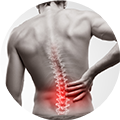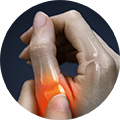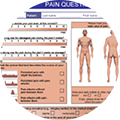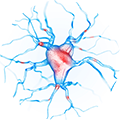
CHRONIC PAIN MANAGEMENT
Learning objectives
By the end of this educational module you should be able to:
1. understand the importance of addressing patients' physical functionality in pain management
2. recognise and assess different types of pain
3. interpret patients’ individual needs in pain management
4. understand the holistic approach to chronic pain management and the role your specialty can play
5. know how to address the needs of patients with chronic pain during the COVID-19 pandemic
Classification and assessment of pain
-
CLASSIFICATION OF PAIN
Pain may be classified according to its location, cause, duration, frequency and intensity.1,2
Nociceptive pain results from activity in neural pathways that are secondary to actual tissue damage or potentially tissue-damaging stimuli3
Neuropathic pain is initiated by nervous system lesions or dysfunction and can be maintained by several different mechanisms3
-
COMORBIDITIES AND PSYCHOSOCIAL FACTORS ASSOCIATED WITH CHRONIC PAIN
COMORBIDITIES PSYCHOSOCIAL FACTORS Obesity:
- There is a substantial amount of evidence suggesting a link between obesity and chronic pain4
- Prevalence of pain increases with progressively higher body mass index4
Beliefs about pain and associated behaviours:5
- influence subsequent cognition and cause fear and catastrophising
- are associated with factors such as
- the level of activity interference
- frequency of pain behaviour
- severity of pain
Depression:
- 40%-60% of patients with chronic pain have depression6
Employment:
- Chronic pain has a substantial negative impact on sickness absence and causes productivity loss7
Diabetes:
- ˜20% of people with diabetes develop neuropathic pain8
-
RECOGNISING DIFFERENT TYPES OF PAIN
The International Association for the Study of Pain (IASP) defines neuropathic pain as pain caused by a lesion or disease of the somatosensory nervous system, and states that "neuropathic pain is a clinical description (and not a diagnosis), which requires a demonstrable lesion or a disease that satisfies established neurological diagnostic criteria."9
According to the IASP definition, nociceptive pain "arises from actual or threatened damage to non-neural tissue and is due to activation of nociceptors."9
There is a group of patients who present clinically with a substantial overlap of nociceptive and neuropathic symptoms. Clinicians have increasingly been using the term ‘mixed pain’ for these patients as the binary classification of pain as being either purely neuropathic or nociceptive left a large proportion of patients unclassified.10
Conditions described as 'mixed pain' in the literature share a common characterisation of clinical manifestation and a substantial overlap of the different known pain types:10
Potential mixed pain states
Sciatica, low back pain, neck pain, cancer pain, osteoarthritis pain, chronic postsurgical pain, musculoskeletal disorders, lumber spinal stenosism chronic joint pain, painful ankylosing sponylitis…
Adapted from Freynhagen R et al, 201910
-
BIOPSYCHOSOCIAL ASSESSMENT OF PAIN
Chronic pain results from a complex and variable interplay between biological, physical, psychological and social factors.11,12 The assessment and management of chronic pain in general practice is challenging because of its complex nature and restrictions imposed by available time and resources. Initial assessment of pain should be holistic and include an evaluation of the severity, impact and type of pain the patient is experiencing:11,12
GPs can use assessment and screening tools that are aimed to help them identify patients at risk of severe chronic pain or complications of chronic pain and to inform their management decisions.12
-
ASSESSMENT TOOLS
Pain assessment tools that are commonly used in primary care and community pain services are:
- Unidimensional scales that quantify only the severity of pain such as Visual Analogue Scale, Visual Rating Scale and Numeric Rating Scale13
- The scales use word descriptors of pain, and/or scores from 0-10, and form the basis for any pain assessment
- On their own, they provide insufficient detail to identify patients with persistent pain presentations and they should be coupled with other instruments for a comprehensive assessment
- Observation of non-verbal behavioural and physiological indicators of pain in the elderly and in people with dementia14
- STaRT Back15
- Developed as a back pain screening tool to identify prognostic indicators relevant to GP decision-making, concerning initial treatment options in primary care15
- MSK-HQ
- A short questionnaire that allows people with musculoskeletal conditions such as arthritis or back pain to report their symptoms and quality of life in a standardised way16
- 'My pain concerns' form17
- Developed to determine what concerns a patient with pain may have before their consultation
- The form contains a checklist with symptoms and changes to a patient’s life that are grouped into categories entitled:
- Diagnosis and cure
- The way I'm feeling
- Changes to my life
- My medications
Pain assessment tools that are commonly used for the assessment of neuropathic pain are:
- PainDETECT12
- Based on patients' self-reported symptoms in a questionnaire covering nine items, the tool is designed to detect if the pain is likely to be neuropathic
- Leeds Assessment of Neuropathic Symptoms and Signs (LANSS)12
- Incorporates sensory description and bedside examination of sensory dysfunction
- Comprises five questions on symptoms and two clinical examination points
- Unidimensional scales that quantify only the severity of pain such as Visual Analogue Scale, Visual Rating Scale and Numeric Rating Scale13
- Cole B E. Pain management: classifying, understanding, and treating pain. Hosp Physician 2002:23-30
- Gangadhar M, Kumar Mishra R et al. Future directions in the treatment of neuropathic pain: a review on various therapeutic targets. CNS Neurol Disord-Drug Targets 2014;13(1):63-81
- Nicholson B. Differential diagnosis: nociceptive and neuropathic pain. Am J Manag Care 2006;12(9 Suppl):S256-262
- Ryan C G, Vijayaraman A et al. The association between baseline persistent pain and weight change in patients attending a specialist weight management service. PLoS One 2017;12(6):e0179227
- Baird A, Sheffield D. The relationship between pain beliefs and physical and mental health outcome measures in chronic low back pain: direct and indirect effects. Healthcare (Basel) 2016;4(3)
- Surah A, Baranidharan G, Morley S. Chronic pain and depression. Contin Educ Anaesth Crit Care Pain 2014;14:85-89
- Patel A S, Farquharson R et al. The impact and burden of chronic pain in the workplace: a qualitative systematic review. Pain Pract 2012;12(7):578-589
- Sloan G, Shillo P et al. A new look at painful diabetic neuropathy. Diabetes Res Clin Pr 2018;144:177-191
- International Association for the Study of Pain. IASP Terminology. Available at: www.iasp-pain.org. Accessed December 2020
- Freynhagen R, Parada H A et al. Current understanding of the mixed pain concept: a brief narrative review. Curr Med Res Opin 2019;35(6):1011-1018
- National Institute for Health and Care Excellence (NICE). Key therapeutic topic (KTT)21. Medicines optimisation in chronic pain. Available at: www.nice.org.uk. Accessed December 2020
- Mills S, Torrance N, Smith B H. Identification and management of chronic pain in primary care: a review. Curr Psychiatry Rep 2016;18(2):22-22
- Grimmer-Somers K, Kumar S et al. Primary care assessment instruments for patients at risk of, or with, persistent pain: opportunistic findings from a systematic literature review. Int J Gen Med 2009;2:121-128
- Jennings A A, Linehan M, Foley T. The knowledge and attitudes of general practitioners to the assessment and management of pain in people with dementia. BMC Fam Pract 2018;19(1):166
- Hill J C, Dunn K M et al. A primary care back pain screening tool: identifying patient subgroups for initial treatment. Arthritis Rheum 2008;59(5):632-641
- Versus arthritis. Musculoskeletal health questionnaire (MSK-HQ). Available at: www.versusarthritis.org. Accessed December 2020
- Pain Concern. My pain concerns form. Available at: painconcern.org.uk. Accessed December 2020
- Breivik H, Collett B et al. Survey of chronic pain in Europe: prevalence, impact on daily life, and treatment. Eur J Pain 2006;10(4):287-333
- National Institute for Health and Care Excellence (NICE). NICE guideline (NG)59. Low back pain and sciatica in over 16s: assessment and management. Available at: www.nice.org.uk. Accessed December 2020
- National Institute for Health and Care Excellence (NICE). Clinical guideline (CG)173. Neuropathic pain in adults: pharmacological management in non-specialist settings. Available at: www.nice.org.uk. Accessed December 2020
- Geneen L J, Martin D J et al. Effects of education to facilitate knowledge about chronic pain for adults: a systematic review with meta-analysis. Syst Rev 2015;4:132
- Morlion B. Pharmacotherapy of low back pain: targeting nociceptive and neuropathic pain components. Curr Med Res Opin 2011;27(1):11-33
- Shanthanna H, Busse J W et al. Local anesthetic injections with or without steroid for chronic non-cancer pain: a protocol for a systematic review and meta-analysis of randomized controlled trials. Syst Rev 2016;5:18-18
- National Institute for Health and Care Excellence (NICE). NICE guideline (NG)144. Cannabis-based medicinal products. Available at: www.nice.org.uk. Accessed December 2020
- Yasaei R, Saadabadi A. Chronic pain syndrome. Available at: www.ncbi.nlm.nih.gov. Accessed December 2020
- Henry S G, Bell R A et al. Goals of chronic pain management: do patients and primary care physicians agree and does it matter? Clin J Pain 2017;33(11):955-961
- Price C, Lee J et al. Initial assessment and management of pain: a pathway for care developed by the British Pain Society. Br J Anaesth 2014;112(5):816-823
- Faculty of Pain Medicine of the Royal College of Anaesthetists. Core standards for pain management services in the UK. 2015. Available at: fpm.ac.uk. Accessed December 2020
- NHS England. Adult specialised pain service specification. Available at: www.england.nhs.uk. Accessed December 2020
- Faculty of Pain Medicine of the Royal College of Anaesthetists. Local commissioning of specialist services for pain. 2013. Available at: www.salg.ac.uk. Accessed December 2020
- Shanthanna H, Strand N H et al. Caring for patients with pain during the COVID-19 pandemic: consensus recommendations from an international expert panel. Anaesthesia 2020;75(7):935-944
- Eccleston C, Blyth F M et al. Managing patients with chronic pain during the COVID-19 outbreak: considerations for the rapid introduction of remotely supported (eHealth) pain management services. Pain 2020;161(5):889-893
- British Pain Society. Pain management during COVID-19 viral infection. Available at: www.britishpainsociety.org. Accessed December 2020
© NICE 2016. Low back pain and sciatica in over 16s: assessment and management. Available from: www.nice.org.uk/guidance/ng59. All rights reserved. Subject to Notice of rights
© NICE 2013. Neuropathic pain in adults: pharmacological management in non-specialist settings. Available from: www.nice.org.uk/guidance/cg173. All rights reserved. Subject to Notice of rights
© NICE 2019. Cannabis-based medicinal products. Available from www.nice.org.uk/guidance/ng144. All rights reserved. Subject to Notice of rights







